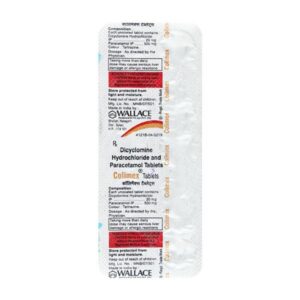DICYCLOMINE + PARACETAMOL
Dicyclomine: Dicyclomine is a drug classified as an antispasmodic and anticholinergic medication. It is primarily used to treat symptoms associated with irritable bowel syndrome (IBS), such as abdominal cramping and pain, bloating, and diarrhea.
The exact mechanism of action of dicyclomine is not fully understood. However, it is believed to work by inhibiting the action of acetylcholine, a neurotransmitter that regulates muscle contractions in the gastrointestinal tract. By blocking the effects of acetylcholine, dicyclomine helps to relax the smooth muscles in the intestines, reducing spasms and relieving symptoms of IBS.
Dicyclomine is typically taken orally in the form of tablets or capsules. The recommended dose for adults is usually 20 mg, taken orally four times a day, before meals and at bedtime. However, the specific dosage may vary depending on the individual’s condition and response to treatment. It is important to follow the instructions provided by a healthcare professional.
As with any medication, dicyclomine may cause certain side effects. The most common side effects include dry mouth, blurred vision, dizziness, drowsiness, difficulty urinating, and constipation. These side effects are generally mild and temporary. However, if any of these side effects persist or worsen, it is advisable to consult a healthcare professional.
In rare cases, dicyclomine may cause more serious side effects such as an allergic reaction, including difficulty breathing, hives, or swelling of the face, lips, tongue, or throat. If any of these symptoms occur, immediate medical attention should be sought.
It is worth noting that dicyclomine may interact with other medications, including certain antidepressants, antihistamines, and muscle relaxants. Therefore, it is important to inform a healthcare professional about all medications being taken to avoid potential drug interactions.
Overall, dicyclomine is a commonly prescribed medication for the relief of IBS symptoms. While it can be effective in managing symptoms, it is important to use the medication as directed and to communicate any concerns or adverse effects to a healthcare professional.
Paracetamol: Paracetamol, also known as acetaminophen, is a widely used over-the-counter pain reliever and fever reducer. It is commonly available in tablet, capsule, liquid, and suppository forms.
Paracetamol is primarily used to alleviate mild to moderate pain such as headache, muscle ache, toothache, and menstrual cramps. It can also reduce fever associated with various conditions like the common cold or flu.
The exact mechanism of action of paracetamol is not fully understood, but it is believed to primarily work by inhibiting the production of certain chemicals called prostaglandins in the brain that are responsible for pain and fever. It mainly acts on the central nervous system.
The usual adult dose of paracetamol for pain relief is 500-1000 mg every 4-6 hours, not exceeding 4000 mg per day. For fever reduction, the same dose can be taken every 4-6 hours as needed, with a maximum of 3000 mg per day. It is important to follow the recommended dose instructions and check with a healthcare professional if unsure about the appropriate dosage for specific conditions or age groups.
While paracetamol is generally considered safe when used as directed, it can have some potential side effects, although rare. Common side effects may include nausea, stomach discomfort, and skin rash. Severe allergic reactions like difficulty breathing, swelling of the face, lips, or tongue are rare but require immediate medical attention.
Taking excessive doses of paracetamol or using it for prolonged periods can potentially lead to liver damage. Therefore, it is crucial to avoid exceeding the recommended dosage and to be cautious when using other medications containing paracetamol as it can accumulate in the body.
It is always advisable to consult a healthcare professional before starting any new medication, including paracetamol, to ensure it is safe and appropriate for an individual’s specific needs and medical history.


